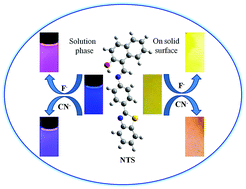Excited state proton transfer (ESIPT) based molecular probe to sense F− and CN− anions through a fluorescence “turn-on” response†
Abstract
A new chromogenic and fluorogenic hydrazone derivative of aminobenzthiazole and 2-hydroxy-1-naphthaldehyde was developed as a sensitive molecular probe, NTS, for the detection of fluoride (F−) and cyanide (CN−) anions. The photophysical and sensing behaviors of the probe, NTS, were investigated by absorption and fluorescence studies. Interestingly, in partial aqueous medium (DMSO/H2O 9 : 1, v/v), the probe shows a selective fluorescence “turn-on” response to both the anions. An excited state proton transfer mechanism (ESPT) has been followed theoretically and by means of spectroscopic studies. The immediate visualized color change of NTS with the respective anions on test paper strips and silica coated slides suggested the applicability of the probe to sense dual anions on solid surfaces and in solution as a chemosensor for fluoride and as a chemodosimeter for cyanide anions, respectively.



 Please wait while we load your content...
Please wait while we load your content...